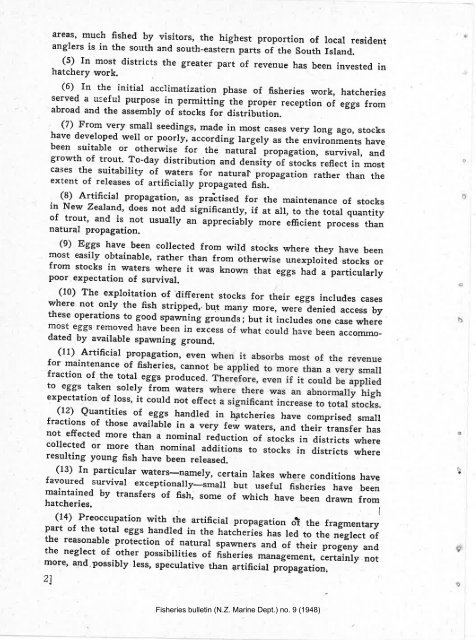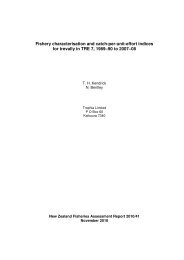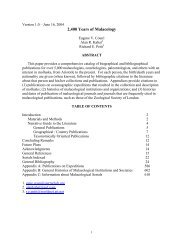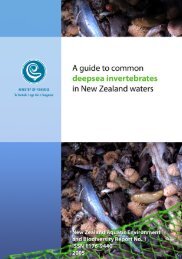N.Z. MARINE DEPARTMENT-FISHERIE,S BULLETIN No. .į
N.Z. MARINE DEPARTMENT-FISHERIE,S BULLETIN No. .į
N.Z. MARINE DEPARTMENT-FISHERIE,S BULLETIN No. .į
You also want an ePaper? Increase the reach of your titles
YUMPU automatically turns print PDFs into web optimized ePapers that Google loves.
areast much fished by visitors, the highest proportion of local resident<br />
anglers is in the south and south-eastern parts of the South rsrand.<br />
(5) rn most districts the greater part of revenue has been invested in<br />
hatchery work.<br />
(6) In the initial acclimatization phase of fisheries work, hatcheries<br />
served a useful purp'ose in_ permitting the proper reception of eggs from<br />
abroad and the assembly of stocks toi ¿istribuiiorr.<br />
- (7) From very small seedings, made in most cases very long ago, stocks<br />
have developed weil or poorry, according largery as the Jnrrironmerrts have<br />
been suitable or otherwise for the trãtut""t irãprg",;", survivar, and<br />
growth of trout. To-day distribution and densiiy of ãto"Ls reflect in ¡nost<br />
cases the suitabirity of waters for naturar pr,ópagation rather than the<br />
extent of releases of artificially propagated fish.<br />
. (Ð A':tificial propagation, as pr4ttised for the maintenance of stocks<br />
in New zealanð,, does not add silnificantry, if at ail, to the totar quantity<br />
of trout, and is not usuaily an appreci"Lly -or" "ffi"i"rrt process than<br />
natural propagation.<br />
(9) Eggs have been colrected from wild stocks where they have been<br />
most easily obtainabre, rathe' than from otherwise unexproited stocks or<br />
from stocks in waters where it was known that eggs rraa " particurarly<br />
poor,expectation of survival.<br />
(10) the exploitation of different stocks for their eggs incrudes cases<br />
where not only the fish stripped, but many more, were denied access by<br />
these operations to good spawning grounds; but it includes one case where<br />
most eggs removed have been in excess of what could have been accommo_<br />
dated by available spawning ground.<br />
(11) Artificial propagation, even<br />
for maintenance of fisheries, cannot<br />
fraction of,the total eggs produced.<br />
to eggs taken solely from waters<br />
expectation of loss, it could not effec<br />
(12) Quantities of eggs handled in h¿tcheries have comprised small<br />
fractions of those availabre in a very r*io *"t"r., ""iinìt,<br />
transfer has<br />
not effected more than a nominar reduction of stocks<br />
collected in districts<br />
or where<br />
more than nominar additions to stocks<br />
resulting i' aistricts<br />
young<br />
where<br />
fish have been released.<br />
(13) rn particular \Maters-namery, certain lakes<br />
favoured<br />
where conditions have<br />
survival exceptionalry-sÁall but useful fisheries<br />
maintained<br />
have been<br />
by transfers of fish, some of which have been hatcheries.<br />
drawn from<br />
(14) Preoccupation with the artificial propagation ol the fragmentary<br />
part of the totar eggs handled in the hatcheiies has red to the negrect of<br />
the reasonabre protectio" .g{ _"1a"ral spawners and of their progeny and<br />
the neglect of other possibilities of füheries manage*"ri, certainl5r not<br />
more,. and,possiþly less, speculative than artificiat prîpagation,<br />
2l<br />
Fisheries bulletin (N.Z. Marine Dept.) no. 9 (1948)<br />
I







